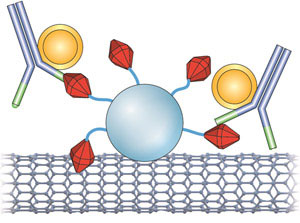| Posted: August 18, 2010 |
Carbon nanotubes could help detect heroin in the body |
|
(Nanowerk News) Carbon nanotubes have charge carriers confined to the nanotube surface, meaning their electrical properties are highly sensitive to changes in their nearby environment. This property has been exploited in recent years to build devices sensitive to gases, proteins, DNA and other substances.
|
|
Nanotubes could now help to detect the illegal narcotic heroin in the human body thanks to work by Ju Nie Tey at A*STAR's Singapore Institute of Manufacturing Technology and co-workers ("Direct Detection of Heroin Metabolites Using a Competitive Immunoassay Based on a Carbon-Nanotube Liquid-Gated Field-Effect Transistor").
|
|
When heroin enters the human body, it is metabolized into 6-monoacetylmorphine (MAM), then morphine, then morphine glucuronide. A simple, cheap method of detecting these compounds in a living person would be useful for purposes of law enforcement and medical treatments.
|
|
Tey and her co-workers built their new sensor in the form of a field-effect transistor (FET), which essentially monitors changes in the conductance of semiconducting nanotubes stretched between metal electrodes. More specifically, they chose a 'liquid-gated' design with a tiny channel to contain the sample solution.
|
 |
| Fig. 1: Morphine antibodies (purple) labeled with gold nanoparticles (yellow) bind to conjugates of the heroin metabolite MAM (red) and bovine serum albumin (blue) on the surface of a carbon nanotube. This affects the charge-carrying properties of the nanotube, indicating the presence of heroin.
|
|
With backgrounds in materials science, electrical engineering and biology, the team was able to design a completely new process for transistor fabrication, stabilize the detection signal, and understand the nature of biomolecules and how they behave in different conditions. The researchers found that the biomolecules bound specifically to the carbon nanotubes and not to other parts of the FET, and there was a significant change in the transistor drain current when morphine antibodies were captured by the receptors on the nanotubes. This signal was amplified further by adding gold nanoparticles to the antibodies.
|
|
However, for real applications in narcotics sensing, it is more useful to detect MAM molecules, which are some 500 times smaller than the antibodies and so produce a much smaller signal. They resolved this problem by carefully tailoring the sample conditions so that gold-labeled antibodies competed to bind with MAM conjugates and thus enhanced the signal (Fig. 1).
|
|
Overall, the device can detect heroin metabolites in concentrations lower than 1 nanogram per milliliter, which is equal to or better than previous methods. Tey is hopeful that this high sensitivity, and the fact that the FETs are simple and inexpensive to construct, are strong selling points for commercializing the device.
|
|
"What we have demonstrated is the potential of the carbon nanotube sensing platform to enhance the detection signal," she says. "It could be extended to other receptor-target systems such as disease diagnosis, herbicide detection, water quality monitoring and more."
|

